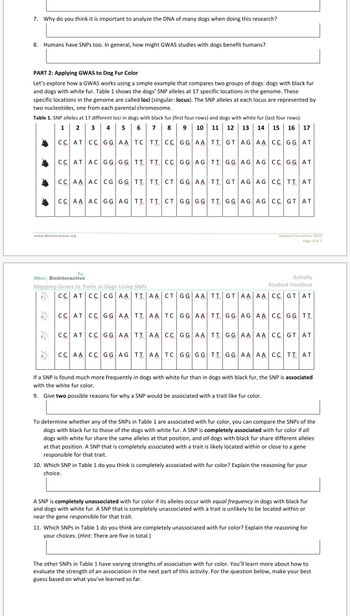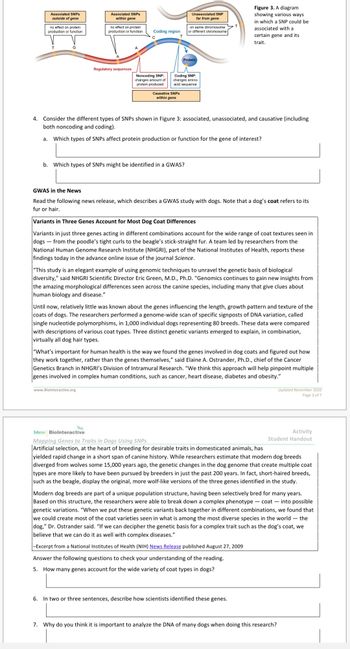
Human Anatomy & Physiology (11th Edition)
11th Edition
ISBN: 9780134580999
Author: Elaine N. Marieb, Katja N. Hoehn
Publisher: PEARSON
expand_more
expand_more
format_list_bulleted
Concept explainers
Question

Transcribed Image Text:7. Why do you think it is important to analyze the DNA of many dogs when doing this research?
8. Humans have SNPs too. In general, how might GWAS studies with dogs benefit humans?
PART 2: Applying GWAS to Dog Fur Color
Let's explore how a GWAS works using a simple example that compares two groups of dogs: dogs with black fur
and dogs with white fur. Table 1 shows the dogs' SNP alleles at 17 specific locations in the genome. These
specific locations in the genome are called loci (singular: locus). The SNP alleles at each locus are represented by
two nucleotides, one from each parental chromosome.
Table 1. SNP alleles at 17 different loci in dogs with black fur (first four rows) and dogs with white fur (last four rows).
1 2 3 4 5 6 7 8 9 10 11 12 13 14 15 16 17
CC AT CC GG AA TCTT CC GG AA TT GT AG AA CC GG AT
*
3:3
CC AT AC GG GG TT TT CC GG AG TT GG AG AG CC GG AT
www.Biolnteractive.org
3:3
CC AA AC CG GG TT TT CT GG AA TT GT AG AG CC TT AT
3:3
CC AA AC GG AG TT TT CT GG GG TT GG AG AG CC GT AT
hhmi Biolnteractive
Mapping Genes to Traits in Dogs Using SNPs
CC AT CC CG AATTAA CT GG AA TTGT AA AA CC GT AT
Updated November 2020
Page 4 of 7
Activity
Student Handout
CC AT CC GG AATTAA TC GG AA TT GG AG AA CC GG TT
CC AT CC GG AATTAA CC GG AA TT GG AA AA CC GT AT
CC AA CC GG AG TTAA TC GG GG TT GG AA AA CC TT AT
If a SNP is found much more frequently in dogs with white fur than in dogs with black fur, the SNP is associated
with the white fur color.
9. Give two possible reasons for why a SNP would be associated with a trait like fur color.
To determine whether any of the SNPs in Table 1 are associated with fur color, you can compare the SNPs of the
dogs with black fur to those of the dogs with white fur. A SNP is completely associated with fur color if all
dogs with white fur share the same alleles at that position, and all dogs with black fur share different alleles
at that position. A SNP that is completely associated with a trait is likely located within or close to a gene
responsible for that trait.
10. Which SNP in Table 1 do you think is completely associated with fur color? Explain the reasoning for your
choice.
A SNP is completely unassociated with fur color if its alleles occur with equal frequency in dogs with black fur
and dogs with white fur. A SNP that is completely unassociated with a trait is unlikely to be located within or
near the gene responsible for that trait.
11. Which SNPs in Table 1 do you think are completely unassociated with fur color? Explain the reasoning for
your choices. (Hint: There are five in total.)
The other SNPs in Table 1 have varying strengths of association with fur color. You'll learn more about how to
evaluate the strength of an association in the next part of this activity. For the question below, make your best
guess based on what you've learned so far.

Transcribed Image Text:Associated SNPs
outside of gene
no effect on protein
production or function.
T
G
Associated SNPs
within gene
no effect on protein
production or function
Regulatory sequences
A
Coding region
с
T
Noncoding SNP:
changes amount of
protein produced
www.Biolnteractive.org
Causative SNPs
within gene
Unassociated SNP
far from gene
on same chromosome
or different chromosome
Protein
Coding SNP:
changes amino
acid sequence
b. Which types of SNPs might be identified in a GWAS?
4. Consider the different types of SNPs shown in Figure 3: associated, unassociated, and causative (including
both noncoding and coding).
a. Which types of SNPs affect protein production or function for the gene of interest?
Figure 3. A diagram
showing various ways
in which a SNP could be
associated with a
certain gene and its
trait.
GWAS in the News
Read the following news release, which describes a GWAS study with dogs. Note that a dog's coat refers to its
fur or hair.
Variants in Three Genes Account for Most Dog Coat Differences
Variants in just three genes acting in different combinations account for the wide range of coat textures seen in
dogs from the poodle's tight curls to the beagle's stick-straight fur. A team led by researchers from the
National Human Genome Research Institute (NHGRI), part of the National Institutes of Health, reports these
findings today in the advance online issue of the journal Science.
"This study is an elegant example of using genomic techniques to unravel the genetic basis of biological
diversity," said NHGRI Scientific Director Eric Green, M.D., Ph.D. "Genomics continues to gain new insights from
the amazing morphological differences seen across the canine species, including many that give clues about
human biology and disease."
Until now, relatively little was known about the genes influencing the length, growth pattern and texture of the
coats of dogs. The researchers performed a genome-wide scan of specific signposts of DNA variation, called
single nucleotide polymorphisms, in 1,000 individual dogs representing 80 breeds. These data were compared
with descriptions of various coat types. Three distinct genetic variants emerged to explain, in combination,
virtually all dog hair types.
"What's important for human health is the way we found the genes involved in dog coats and figured out how
they work together, rather than the genes themselves," said Elaine A. Ostrander, Ph.D., chief of the Cancer
Genetics Branch in NHGRI's Division of Intramural Research. "We think this approach will help pinpoint multiple
genes involved in complex human conditions, such as cancer, heart disease, diabetes and obesity."
6. In two or three sentences, describe how scientists identified these genes.
Updated November 2020
Page 3 of 7
hhmi Biolnteractive
Mapping Genes to Traits in Dogs Using SNPs
Artificial selection, at the heart of breeding for desirable traits in domesticated animals, has
yielded rapid change in a short span of canine history. While researchers estimate that modern dog breeds
diverged from wolves some 15,000 years ago, the genetic changes in the dog genome that create multiple coat
types are more likely to have been pursued by breeders in just the past 200 years. In fact, short-haired breeds,
such as the beagle, display the original, more wolf-like versions of the three genes identified in the study.
Activity
Student Handout
Modern dog breeds are part of a unique population structure, having been selectively bred for many years.
Based on this structure, the researchers were able to break down a complex phenotype-coat - into possible
genetic variations. "When we put these genetic variants back together in different combinations, we found that
we could create most of the coat varieties seen in what is among the most diverse species in the world the
dog," Dr. Ostrander said. "If we can decipher the genetic basis for a complex trait such as the dog's coat, we
believe that we can do it as well with complex diseases."
-Excerpt from a National Institutes of Health (NIH) News Release published August 27, 2009
Answer the following questions to check your understanding of the reading.
5. How many genes account for the wide variety of coat types in dogs?
7. Why do you think it is important to analyze the DNA of many dogs when doing this research?
Expert Solution
This question has been solved!
Explore an expertly crafted, step-by-step solution for a thorough understanding of key concepts.
This is a popular solution
Trending nowThis is a popular solution!
Step by stepSolved in 5 steps

Knowledge Booster
Learn more about
Need a deep-dive on the concept behind this application? Look no further. Learn more about this topic, biology and related others by exploring similar questions and additional content below.Similar questions
- SNP variations may be found at every nucleotide in the human genome. True Falsearrow_forwardhe chances of an individual having a particular group of variable number tandem repeats (VNTRs) can be calculated. If 3 VNTRs are analyzed, one of which has 40 known variations while the other 2 have thirty known variations each, what is the chance of an individual having any specific banding pattern? a 36,000 b 100 c 1/100 d 1/36,000arrow_forwardCan you please answer number 4arrow_forward
- asap please.arrow_forward31. The enzymes required to breathe fire (BFi2) is expressed in throat tissues of dragons from the Known World (comprising Westeros, Essos, Sothyros and Ulthos) at various times during their life cycles. A test very similar to DNase I hypersensitivity is conducted on embryonic (E) and adult (A) throat tissue samples of Valeriyan, Ice and Sea dragons. In the analysis, a radioactive label is attached to one end of each chromosome fragment, and the samples from each tissue are exposed to DNase I to determine if regions of BFi2 are DNase I hypersensitive. The content from each sample is then separated by gel electrophoresis and the results are shown below. Based on the gel results, in which tissue(s) and at what times during development do the results indicate the expression of BFi2 is most likely taking place?arrow_forwardtraffic deaths in 10 years. Does daylight savings time increase the number of traffic deaths? (Many countries are in the process of getting rid of the time change - even though the Senate did vote to stop the time change the legislation seems to have stalled (as usual!)). 6) Epistasis is a phenomenon in which one gene controls the expression of another. In one case, a dihybrid cross should yield a 9:3:4 ratio. You collect the following data on mice: black coat: 218 Is there any reason to doubt the ratio of 9 black: 3 brown : 4 white? brown coat: 76 white coat: 89arrow_forward
arrow_back_ios
arrow_forward_ios
Recommended textbooks for you
 Human Anatomy & Physiology (11th Edition)BiologyISBN:9780134580999Author:Elaine N. Marieb, Katja N. HoehnPublisher:PEARSON
Human Anatomy & Physiology (11th Edition)BiologyISBN:9780134580999Author:Elaine N. Marieb, Katja N. HoehnPublisher:PEARSON Biology 2eBiologyISBN:9781947172517Author:Matthew Douglas, Jung Choi, Mary Ann ClarkPublisher:OpenStax
Biology 2eBiologyISBN:9781947172517Author:Matthew Douglas, Jung Choi, Mary Ann ClarkPublisher:OpenStax Anatomy & PhysiologyBiologyISBN:9781259398629Author:McKinley, Michael P., O'loughlin, Valerie Dean, Bidle, Theresa StouterPublisher:Mcgraw Hill Education,
Anatomy & PhysiologyBiologyISBN:9781259398629Author:McKinley, Michael P., O'loughlin, Valerie Dean, Bidle, Theresa StouterPublisher:Mcgraw Hill Education, Molecular Biology of the Cell (Sixth Edition)BiologyISBN:9780815344322Author:Bruce Alberts, Alexander D. Johnson, Julian Lewis, David Morgan, Martin Raff, Keith Roberts, Peter WalterPublisher:W. W. Norton & Company
Molecular Biology of the Cell (Sixth Edition)BiologyISBN:9780815344322Author:Bruce Alberts, Alexander D. Johnson, Julian Lewis, David Morgan, Martin Raff, Keith Roberts, Peter WalterPublisher:W. W. Norton & Company Laboratory Manual For Human Anatomy & PhysiologyBiologyISBN:9781260159363Author:Martin, Terry R., Prentice-craver, CynthiaPublisher:McGraw-Hill Publishing Co.
Laboratory Manual For Human Anatomy & PhysiologyBiologyISBN:9781260159363Author:Martin, Terry R., Prentice-craver, CynthiaPublisher:McGraw-Hill Publishing Co. Inquiry Into Life (16th Edition)BiologyISBN:9781260231700Author:Sylvia S. Mader, Michael WindelspechtPublisher:McGraw Hill Education
Inquiry Into Life (16th Edition)BiologyISBN:9781260231700Author:Sylvia S. Mader, Michael WindelspechtPublisher:McGraw Hill Education

Human Anatomy & Physiology (11th Edition)
Biology
ISBN:9780134580999
Author:Elaine N. Marieb, Katja N. Hoehn
Publisher:PEARSON

Biology 2e
Biology
ISBN:9781947172517
Author:Matthew Douglas, Jung Choi, Mary Ann Clark
Publisher:OpenStax

Anatomy & Physiology
Biology
ISBN:9781259398629
Author:McKinley, Michael P., O'loughlin, Valerie Dean, Bidle, Theresa Stouter
Publisher:Mcgraw Hill Education,

Molecular Biology of the Cell (Sixth Edition)
Biology
ISBN:9780815344322
Author:Bruce Alberts, Alexander D. Johnson, Julian Lewis, David Morgan, Martin Raff, Keith Roberts, Peter Walter
Publisher:W. W. Norton & Company

Laboratory Manual For Human Anatomy & Physiology
Biology
ISBN:9781260159363
Author:Martin, Terry R., Prentice-craver, Cynthia
Publisher:McGraw-Hill Publishing Co.

Inquiry Into Life (16th Edition)
Biology
ISBN:9781260231700
Author:Sylvia S. Mader, Michael Windelspecht
Publisher:McGraw Hill Education